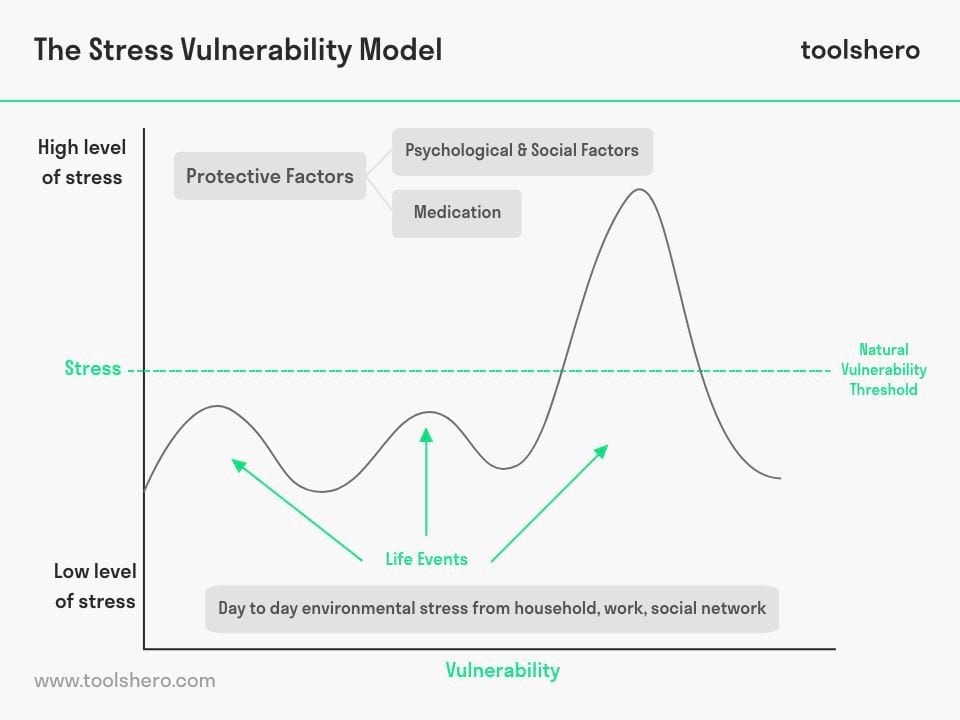Diathesis Stress Model: a psychology theory

Diathesis stress model: This article explains the diathesis stress model in a practical way. It covers a definition of the model, as well as an explanation of its use in psychology, along with examples. It also provides tips on dealing with stress. After reading this article, you will understand the basics of this powerful psychology method. Enjoy reading!
What is the Diathesis stress model?
Diathesis Stress Model definition
The Diathesis stress model or stress vulnerability model is a theory from psychology that explains disorders as a result of an interaction between vulnerability, diathesis and stress as a result of life experiences.
The term diathesis comes from Greek and means something like predisposition or sensitivity. A diathesis. There are various forms of this diathesis. These depend on psychological, genetic, biological or situational factors.
Stress arises from life events or other events that have disrupted a person’s psychological balance. Stress has the ability to catalyze the development of a disorder. That is, stress can be a stimulator for the development of a psychological disorder.
The diathesis stress model is used to investigate how biological or genetic factors interact with stressors causing disorders such as anxiety, depression and schizophrenia. The model states that if the combination of predisposition and stress exceeds a certain limit, the person will develop a disorder in the short term.

Figure 1 – Diathesis Stress Model / Stress Vulnerability Model
Origin and use in Psychology
The term diathesis was coined in medicine and psychiatry and comes from the 19th century. The diathesis stress model only became popular when it was used in the 1960s to explain schizophrenia. Joseph Zubin, a Lithuanian-American psychologist, used the concept to explain schizophrenia.
How is the diathesis stress model used?
The model is used in many areas of psychology. An example of this is the development of psychopathology.
It is also helpful to understand the relationship and interplay between nature vs. nurture in the search for susceptibility to disorders throughout a human’s lifespan.
The model is furthermore useful for explaining the context of a depression. For example, it helps explain why Person A becomes depressed and Person B does not, even though they are exposed to the same factors and stressors.
More recently, the model helped explain why some people are more at risk of developing a disorder than others. A child with a family in which depression is present is more likely to develop a disorder than children who do not. Children who have experienced exclusion from friends or family are also more likely to develop a psychological disorder.
Protective factors for developing a disorder
There are so-called protective factors that counteract the effects of stressors and thus can prevent the consequences of a developed disorder. In many of these disorders, there is a limited amount of time in which the person is more likely to develop a disorder.
Examples of these protective factors are high-quality and positive social networks and a high self-esteem.
The protective factors help explain why some people don’t develop a psychological disorder when they do have severe diathesis and stress. In these cases, therefore, certain factors prevent the condition from coming to the surface.
Psychological disorders during a lifetime
Many models that show how psychopathology works suggest that all people have some degree of vulnerability to developing a psychological disorder. Yet there are major differences in the explanation of exactly when in a human life this happens.
A person with personality traits such as extroversion and friendliness is good at entering into new relationships.
He or she therefore more often has strong social support than people who do not. This social support can later develop into a protective factor when a lot of stress is experienced. They can also delay or even prevent the development of depression.
Conversely, a person who finds it difficult to form new relationships may be more vulnerable to developing a psychological disorder. That’s because this person doesn’t have a strong protective factor. The threshold whether someone develops an abnormality is determined by the interaction of stress and diathesis.
Windows of vulnerability
It is believed that at various times in life a person is especially vulnerable to developing a psychological disorder.
A breakup or other traumatic stressor can be involved in the development of depression. Stressful events can also trigger a manic phase of bipolar disorder. A new stressful event can then hinder recovery and cause another relapse.
Having a genetic predisposition to drink a lot during college with drinking games can be a factor in developing alcoholism later in life.
A family history in which schizophrenia is not unknown, coupled with stress factors such as growing up in an unorganized family, increases the risk of developing a psychological disorder such as schizophrenia.
Genetic predisposition to developing a psychological disorder
Also, receiving a particular temperament trait, such as sensory processing sensitivity (SPS), increases the vulnerability to developing psychological disorders. SPS is associated with increased sensitivity in the central nervous system and deeper cognitive processing of social, physical, and emotional stimuli.
The trait is characterized by the tendency to pause in new situations and to check the situation. These people have a greater sensitivity to stimuli and use deeper cognitive processing strategies for applying coping styles. These are driven by heightened emotional reactivity.
SPS is an inherited and conserved trait. It is associated with an increased level of information processing in the brain, which moderates sensitivity to environments in positive and negative ways.
Interaction with negative experiences increases the risk of a psychopathology, such as a depression or disorder. Interacting with positive experiences actually increases positive results.
Stress Management: 40+ easy ways to deal with stress
Stress relief and burnout prevention. Don’t let stress control your life. Beat anxiety and worries. Live, Laugh, Love.
Diathesis Stress Model and how to deal with stress?
Stress is the culprit or trigger of many different negative influences. It is therefore important to avoid bad stress as much as possible.
Diet and exercise
The extent to which a person moves and eats healthy has a lot of influence on the production and release of stress hormones such as cortisol. Serotonin, one of the neurotransmitters that affects a person’s happiness, is produced in the gut.
It is therefore important to keep the intestines optimally healthy. Physical and mental health are more closely linked than many people think.
Sleep
A regular sleep pattern with about 8 hours of sleep helps to rest and grow, both physically and mentally. Sleep is important for maintaining the 24-hour clock in the body. That rhythm helps a body fall asleep and wake up. That is regulated by hormones. When you wake up, the body mainly releases cortisol.
A disturbed sleep rhythm therefore stands in the way of a properly functioning hormone release. This can lead to various complaints, such as an increased appetite and increased blood pressure.
Set boundaries
Stress often arises because a person becomes overwhelmed. There are 24 hours in a day, 8 of which you sleep. An excess of tasks and responsibilities can cause a person to reach the limit. It is difficult to learn to say no for many people. Still, it’s a good idea to say no when you’re suffering physically and mentally. The easiest way to deal with a stressful schedule is to relieve it.
Diathesis Stress Model: deal with stress
Do you experience a lot of stress despite taking measures? Then take a moment every now and then to pause, breathe and reflect on how you feel. You might consider keeping an emotion diary. Emotions are processed by different parts of the brain. As you write about your feelings, you may just start to see things from a new perspective.
You don’t have to spend a lot of time keeping a journal. Five minutes every day is often enough. Briefly write about what happened that day and how it made you feel.
Now it’s your turn
What do you think? Do you recognize the explanation about the Diathesis stress model/ stress vulnerability model? Do you think you are vulnerable to developing a psychological disorder? Do you have protective factors such as close family and a close circle of friends? Do you have any tips or comments?
Share your experience and knowledge in the comments box below.
More information
- Walker, E. F., & Diforio, D. (1997). Schizophrenia: a neural diathesis-stress model. Psychological review, 104(4), 667.
- Swearer, S. M., & Hymel, S. (2015). Understanding the psychology of bullying: Moving toward a social-ecological diathesis–stress model. American Psychologist, 70(4), 344.
- Broerman, R. (2020). Diathesis-stress model. Encyclopedia of personality and individual differences, 1107-1109.
How to cite this article:
Janse, B. (2022). Diathesis Stress Model. Retrieved [insert date] from Toolshero: https://www.toolshero.com/psychology/diathesis-stress-model/
Original publication date: 08/15/2022 | Last update: 12/25/2023
Add a link to this page on your website:
<a href=”https://www.toolshero.com/psychology/diathesis-stress-model/”>Toolshero: Diathesis Stress Model</a>












